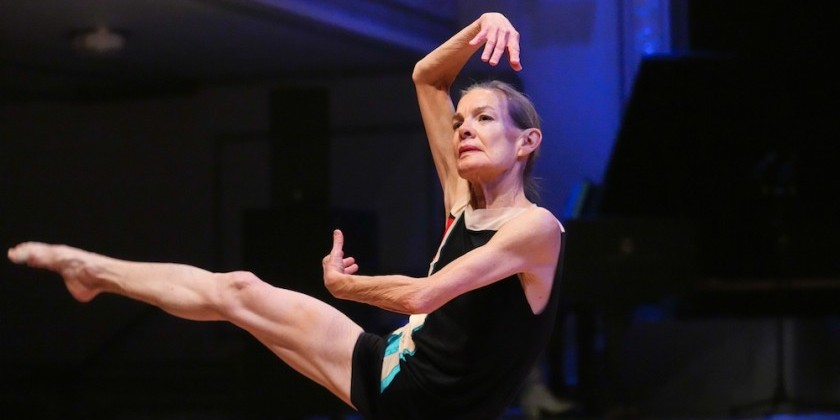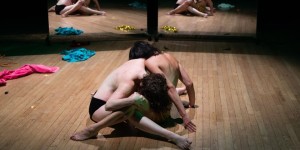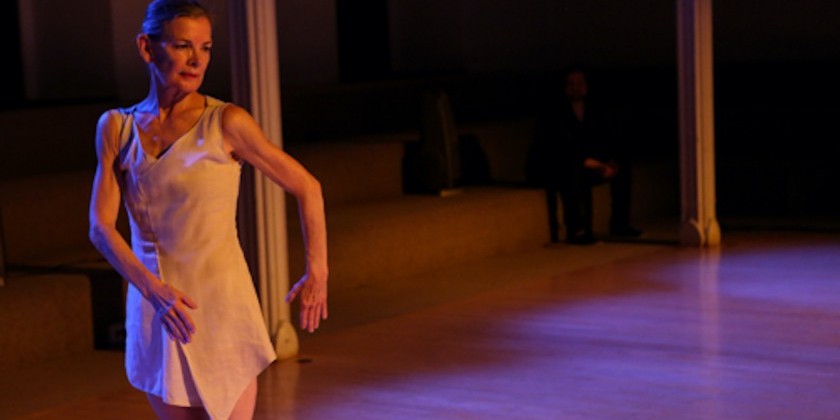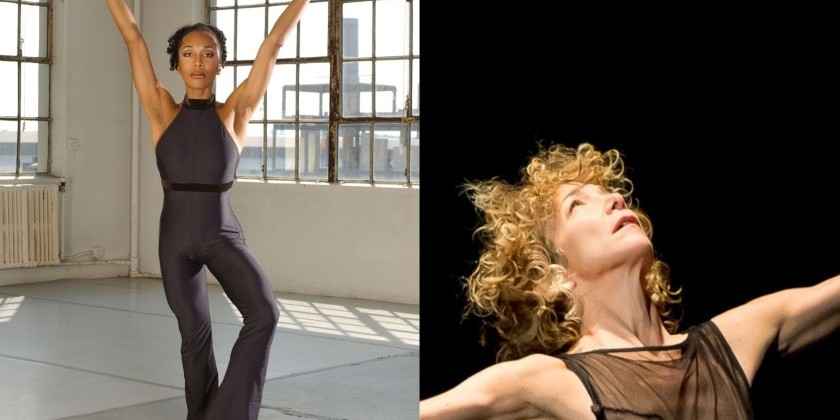IMPRESSIONS: Molissa Fenley and Company in "From the Light, Between the Lamps" at Roulette Intermedium

Choreography by Molissa Fenley // Performed by Christiana Axelsen, Molissa Fenley, Justin Lynch, and Timothy Ward // Guest performers on February 2-3 only: Michael Trusnovec, Lloyd Knight, and Cassandra Trenary
Lighting by David Moodey, assisted by Natasha Rotondaro
Technical Director Ian Bjornstad // Costumes by Khadda Madani and Jill S. Clair
Live music by Michael Ferrara and Enriqueta Somarriba
Music: Cosmati Variations #5 by John Cage, Third Construction // Current Pieces #1-3 performed live by Enriqueta Somarriba on piano // #1 by Vijay Iyer, Crown Thy Good // #2 by Nico Muhly, Refine // #3 by JP Jofre, Air on America // Etruscan Matisse/Blake by Ryuichi Sakamoto, 20210310 // Lava Field by John Bischoff, Piano 7hz // De La Lumière, Entre les Lampes by Philip Glass, New Chaconne performed live by Michael Ferrera on piano // In the Garden (with Ryuichi) – birdsong
Veteran dancemaker Molissa Fenley is well known and regarded for the athletic rigor of her dances—and her dancing, the clarity of which continues to astonish through her seventh decade. In From the Light, Between the Lamps, she and three equally astonishing dancers take on a marathon buffet of six short pieces, all created or revised within the past few years. The dances activate the multidimensional space of Roulette Intermedium to generous effect, allowing for a viewing experience that is at once intimate and expansive.

Etruscan Matisse/Blake with Timothy Ward, Christiana Axelsen, Molissa Fenley and Justin Lynch; photo by Whitney Browne
As one might expect from a buffet, the fare is varied — in tone and texture, structure and sensibility — and together span an impressive palette of movement vocabularies and musical relationships. Balance is struck through the dynamic interplay of tensions: formalism and freedom, rhythm and flow, the individual and the group. Fenley draws inspiration from visual art, architecture, and ecology to spark kinetic dialogues that extend into the aural spheres of longtime collaborators, including composers John Cage, Philip Glass, and Ryuichi Sakamoto. With this constellation of influences the choreographer spools a subtle aesthetic throughline that marks each of the dances as a glinting facet of something uniquely hers.
Likewise, the dancers own the movement, relishing its rigor and reveling in its turn-on-a-dime oscillations between deft simplicity and bristling complexity. The music — equally varied — is their medium, the current through which they engage and respond with buoyancy and resistance. Their sweat doesn’t even begin to dry in the time between costume changes, yet even as their breath becomes labored their eyes brighten, faces open to the soft flash of a slight, knowing smile as they egg themselves and each other on.

Cosmati Variations, Variation 5 with Christiana Axelsen and Timothy Ward; photo by Whitney Browne
Cosmati Variations #5, for Christiana Axelsen and Timothy Ward to a 1941 Cage score for assorted percussion, chases clear-cut yet unpredictable rhythms and geometries with casual exactness. Here Fenley draws from the designs of elaborate medieval Italian mosaics to create sinuous patterns that decorate the air in the dancers’ wakes. Momentarily stilled and flattened, they spring into action and dimension: whirling eddies, braided counterpoints, and brief shining unisons. Though they scarcely touch, their eyes meet to sustain an intimacy heightened by the momentary gentle joining of hands.

Fenley takes the stage to lead off a trio of finely wrought, decidedly unromantic solos in Current Pieces #1-3, set to distinct recompositions of “America the Beautiful” played live on piano by Enriqueta Somarriba. Motifs cohere, dissolve, and redirect: wide-armed spools of turns, chains of small arcing leaps, rounded arms tracked together across the body like the passage of the sun over the horizon. Axelsen brings soft-eyed curiosity to her undulations while Ward’s passing moods range from tenderness to a sharp angularity that gives way to languid unfurling. Pliant, steely spines sustain the tonal drama, turning and returning as a means of searching or seeing.
This quiet mastery of the solo form expands in three works that showcase the full ensemble, rounded out by the sublimely serene Justin Lynch. While the dances employ similar spatial and compositional devices, their vocabularies are distinctly defined to reflect and amplify their musical and thematic auras. In each the choreographer makes effective use of Roulette’s multi-level architecture, beginning with the open space at the audience’s feet and rising and receding into a tight proscenium. Dancers placed at different levels and distances from the eye give a sense of stretching across time and space.

In the Garden (with Ryuichi) starring Justin Lynch (foreground) and Molissa Fenley (background); photo by Whitney Browne
In each encounter, the tone of their isolation and togetherness shifts. They echo, mirror, orbit, and collide through a fractaled sequence of precisely measured shapes, each with their own timing and orientation. In Etruscan Matisse/Blake, Lynch is set apart from a trio that weaves and unweaves through sculptural tableaus; it is their shared vocabulary that draws out the resonance between states of aloneness and togetherness. Lava Field’s upright, direct focus and rigid stackings and collapsings suit the mechanical buzzes and chimes of its spare score, making it perhaps the most opaque work of the evening. By contrast, In the Garden (with Ryuichi) is the evening’s most evocative. Set to the sounds of birdsong, its movements paint a landscape: a tree in the breeze, a vine as it grows, the grass waving, birds signaling dawn. The whole body morphs slowly from shape to shape in a meditative ritual that glimmers with a more-than-human power.

Etruscan Matisse/Blake with Christiana Axelsen, Justin Lynch, and Molissa Fenley; photo by Whitney Browne
Though each offering in Fenley’s buffet leaves a distinct impression, De La Lumière, Entre les Lampes is a morsel worth savoring. In it the choreographer fleshes out two duets to a newly composed piano score by Philip Glass, played live by Michael Ferrara. Glass’s signature cascades of short phrases circle and build in subtly iterative melodic crescendos tailor-made for the cadences of Fenley’s run-on choreographic sentences. Clad in muted tones of blue, the pairings — Axelsen and Lynch followed by Lynch and Ward — bloom with gracious sensitivity. Amid their skimming and soaring, simple gestures of rare beauty catch the heart: a hand laid softly on the shoulder, palms gently open to hold something precious.

De la Lumière, Entre les Lampes with Justin Lynch and Timothy Ward; photo by Steven Pisano
This dancing together is about being together, not for the effect but for the sheer empathic pleasure of it. Through interruptions and redirections, movement and music retain a sense of homecoming, though one which is always changing and always changed — an apt reflection of an artist whose perennial curiosity remains fresh in her fifth decade of making dances.












